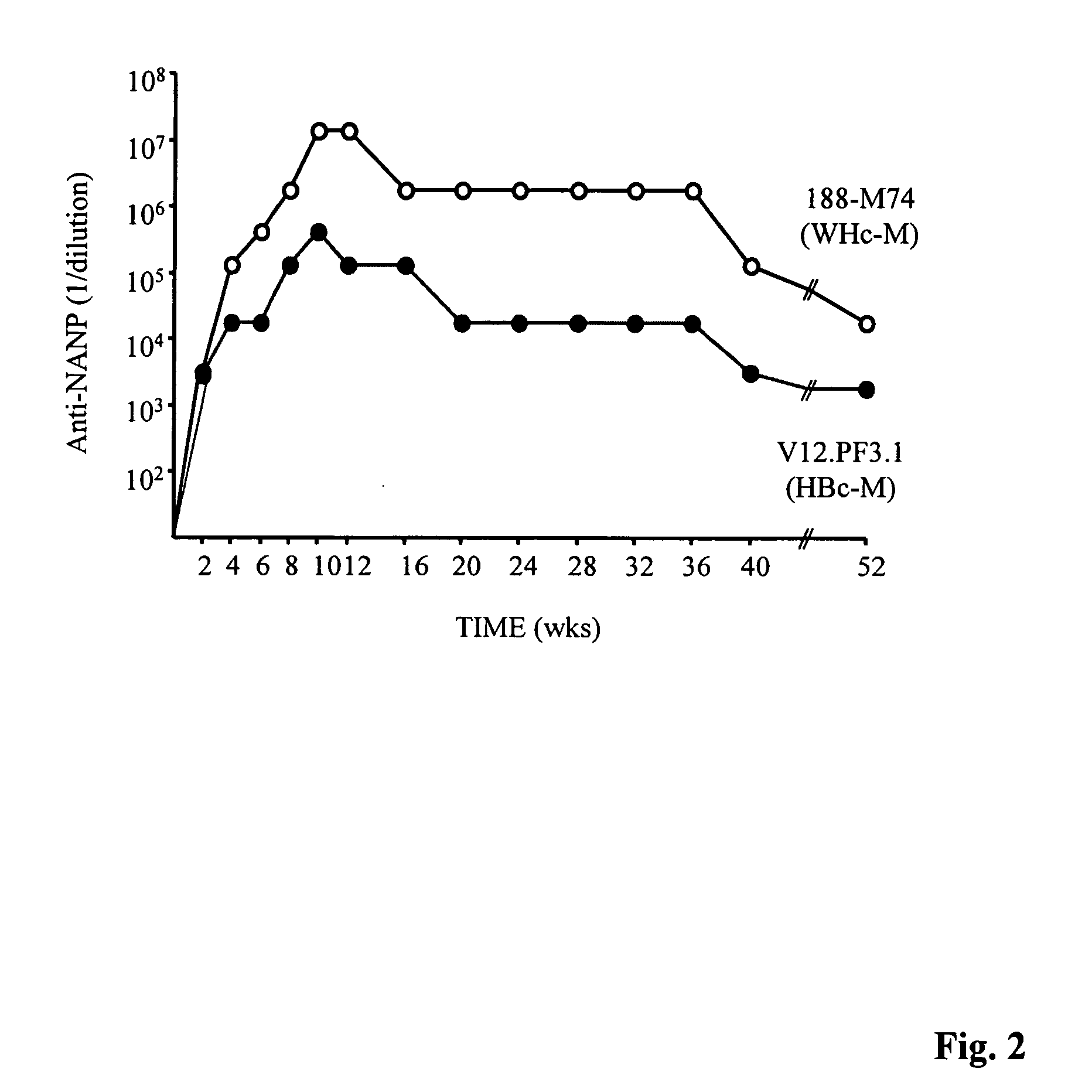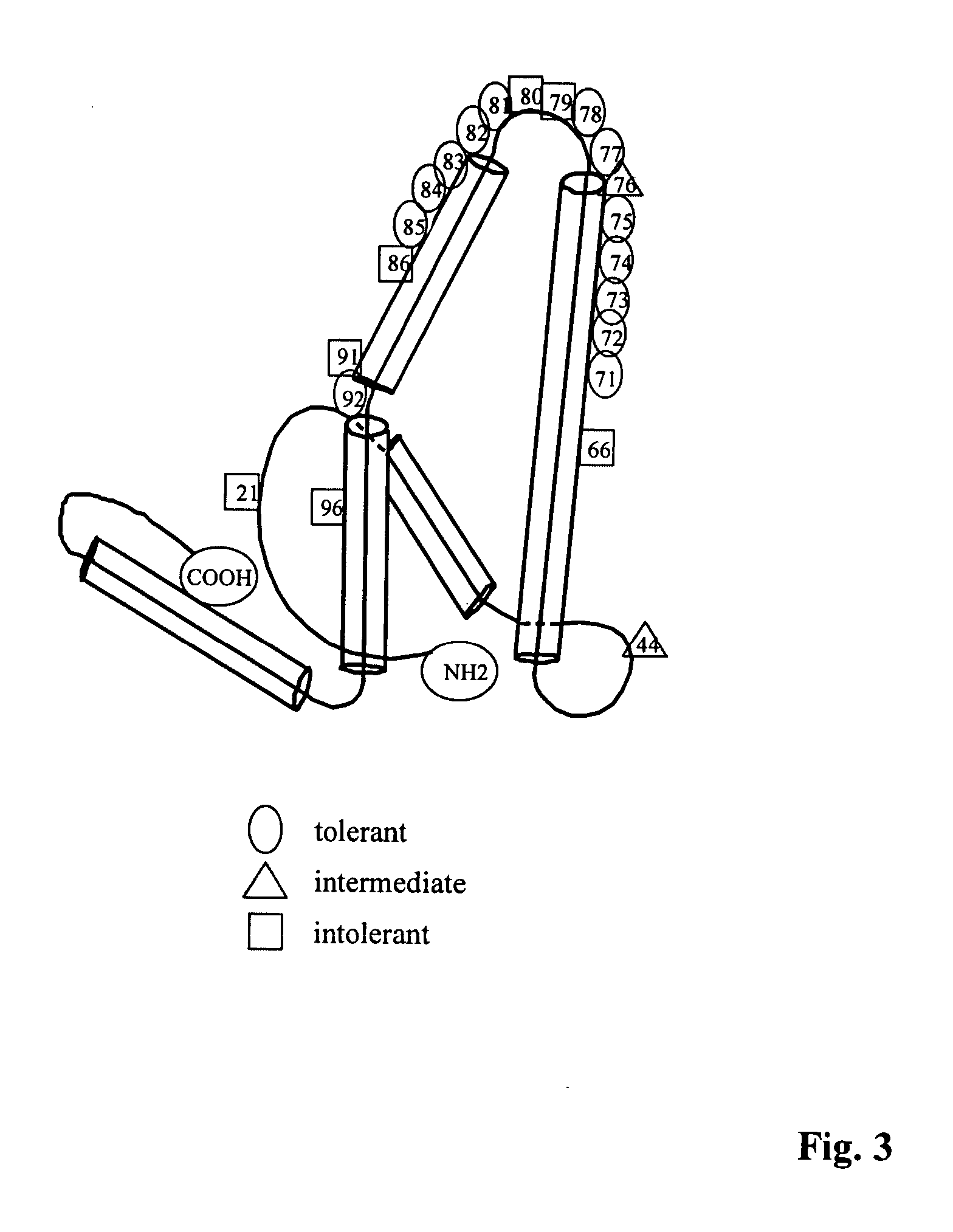Human hepatitis B virus core proteins as vaccine platforms and methods of use thereof
a technology core proteins, which is applied in the field of human hepatitis b virus core proteins as vaccine platforms, can solve the problems of insufficient realization of the promise of hapten-like technology, insufficient efficiency and reproducibility methods, and the limitations of existing hbcag-based platform technology, etc., and achieves enhanced nucleic acid uptake by cells
- Summary
- Abstract
- Description
- Claims
- Application Information
AI Technical Summary
Benefits of technology
Problems solved by technology
Method used
Image
Examples
example 2
Antibody Assays
[0291] Anti-WHcAg or peptide antibodies were measured in pooled or individual, murine sera by indirect solid phase ELISA using solid phase WT WHcAg (50ng / well) or insert peptide (0.5 .mu.g / well) and goat anti-mouse Ig (or IgG isotype-specific) antibodies were used as the secondary antibody. The ELISA was developed with a peroxidase-labelled, affinity-purified swine anti-goat Ig. The data were expressed as antibody titer representing the highest dilution yielding three times (3.times.) the optical density of the pre-immunization sera. Anti-PS antibodies were measured in an identical manner on solid phase purified PSs (10 .mu.g / ml), except that PolySorp plates (Nunc, Rosklide, Denmark) were used to coat PS antigens. Fifty micrograms of pneumococcal cell wall polysaccharide (C-PS) per ml of sera were added to absorb any anti-C-PS antibodies.
example 3
T Cell Assays
[0292] To measure T cell proliferation, groups of 3-5 mice were primed with either 10 .mu.g of WT core, hybrid core or PS-core conjugates by hind footpad injection. Approximately, 7-10 days after immunization, draining popliteal lymph node (LN) cells were harvested, and 5.times.10.sup.5 cells in 0.1 ml of Click's medium were cultured with 0.1 ml of medium containing WT core, hybrid core or PS-core conjugates, various synthetic peptides, or medium alone. Cells were cultured for 96 hr at 370 C in a humidified 5% CO.sub.2 atmosphere, and during the final 16 hr, 1 .mu.Ci of 3H-thymidine (3H-TdR; at 6.7 Ci / mmol, New England Nuclear, Boston, Mass.) was added to each well. The cells were then harvested onto filter strips for determination of .sup.3H-TdR incorporation. The data were expressed as counts per minute corrected for background proliferation in the absence of antigen (.DELTA.cpm). The T cell nature of the proliferation was confirmed by analyzing nylon-wool column-enri...
example 4
In Vivo Antibody Production in Response to WHcAg Immunization
[0293] It was not obvious that the WHcAg and the HBcAg would behave similarly as antigens or as immunogens, because the WHcAg and the HBcAg are only approximately 67% conserved at the amino acid level. In addition, the HBcAg and the WHcAg migrate very differently in a 1% agarose gel (See, FIG. 4). Furthermore, the WHcAg and the HBcAg do not significantly crossreact at the antibody (B cell) level (See, FIG. 6) and are only partially crossreactive at the CD4.sup.+ T helper cell level (See, FIGS. 7-10). Therefore, a number of studies were conducted to determine the immunogenicity of the WHcAg for evaluation of its potential as a vaccine carrier platform.
[0294] Briefly, eight H-2 congenic murine strains, differing only in MHC-haplotype, were immunized with equal doses of WHcAg or HBcAg (7.0 .mu.g) emulsified in incomplete Freund's adjuvant (IFA). As shown in FIG. 5, the WHcAg elicited higher levels of anti-core antibodies in 5...
PUM
| Property | Measurement | Unit |
|---|---|---|
| diameter | aaaaa | aaaaa |
| molecular weights | aaaaa | aaaaa |
| molecular weights | aaaaa | aaaaa |
Abstract
Description
Claims
Application Information
 Login to View More
Login to View More - R&D
- Intellectual Property
- Life Sciences
- Materials
- Tech Scout
- Unparalleled Data Quality
- Higher Quality Content
- 60% Fewer Hallucinations
Browse by: Latest US Patents, China's latest patents, Technical Efficacy Thesaurus, Application Domain, Technology Topic, Popular Technical Reports.
© 2025 PatSnap. All rights reserved.Legal|Privacy policy|Modern Slavery Act Transparency Statement|Sitemap|About US| Contact US: help@patsnap.com



